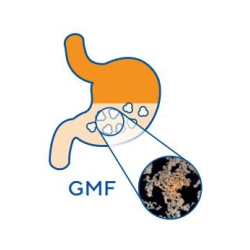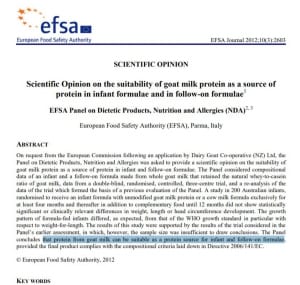
Kabrita: Safe & healthy growth for infants
Goat milk has been proven to be a good base for infant formula. The natural composition of goat milk has been demonstrated to be closer to the composition of human milk than cow’s milk (i.e. bovine milk) with regard to a variety of aspects.1,2 Although goat milk more closely resembles human milk, goat milk still needs to be modified to fulfil an infant’s specific needs.

Approval by authorities
In 2012, the European Food Safety Authority (EFSA) gave a positive opinion on the suitability of goat milk as protein source for infant- and follow-on formulas, provided that the final product complies with the compositional criteria laid down in Directive 2016/127/EC. The EFSA based its opinion on data from a double-blind, randomized, controlled study testing infant formula and a follow-on formula made from whole goat milk with the natural whey-to-casein ratio of goat milk.3
In 2017, Ausnutria’ s goat whey protein concentrate and non-fat dry goat milk are considered “Generally Recognized As Safe” (GRAS GRN No. 644) by the FDA. Ausnutria developed a specific goat milk formula complying with regulations in different regions. For Europe, it complies with Directive 2016/127/EC, as regards the specific compositional and information requirements for infant formula and follow-on formula.
In 2023, FDA’s review of Kabrita’s Goat Milk-Based Infant Formula has been completed. Kabrita’s Goat Milk Infant Formula is the first European infant formula to meet the FDA’s nutrition and safety requirements and will increase availability of infant formula across the United States (FDA, June 23, 2023). This review was based on a double-blind, randomized, controlled trial meeting FDA’s requirements, comparing Kabrita Goat Milk-Based Infant Formula to cow’s milk formula and using breast-fed infants as a reference group.4 This study showed that Kabrita Goat Milk-Based Infant Formula is safe, well tolerated and resulted in healthy growth in infants. More information about this study in the section below “Kabrita’s infant studies”.

Click on the infographic and video below for a quick overview of goat milk protein as safe source for infant formula.
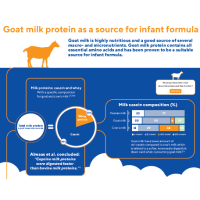
Infographic: goat milk protein
Kabrita’s infant studies
Kabrita formula has been successfully investigated by Ausnutria regarding its safety, tolerance and nutritional adequacy in multiple Ausnutria infant studies and a meta-analysis.
1. Double-blind randomized controlled trial (n=304)
The first study was a double-blind randomized controlled trial (n=304) to determine the growth and safety parameters in new-borns fed Kabrita, in which a cow milk formula (CMF) served as a control and a breast fed (BF) group as a reference during sixteen weeks of intervention. 4 Healthy term infants aged up to 14 days old were recruited from 25 European study centres. Z-scores for weight-for-age, weight-for-length and length-for-age of infants using Kabrita (n=111) were compared to the z-scores of infants using CMF (n=107) or human milk (n=86). The z-scores for weight-for-age is a parameter comparing the weight of an infant at a specific age to WHO reference growth charts. This study showed that weight gain and z-scores for anthropometric measurements were similar between the formula groups. Incidences of serious adverse events and reflux, fussiness, colic, and flatulence were similar among the three groups. This study demonstrates that Kabrita provides healthy growth, has a good tolerability, and is safe to use in infants from birth onwards.
Click on the paper below for more information about this double-blind randomized controlled trial.
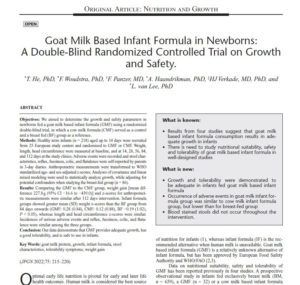
Paper: Kabrita RCT (He et al. 2022)
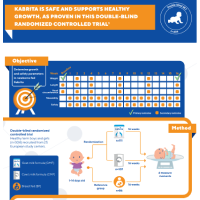
Infographic: Kabrita RCT
2. Randomized double-blind controlled trial in Brazil
The second study was a randomized double-blind controlled trial in Brazil and investigated the growth of infants (n=56) using Kabrita formula or cow’s milk formula (CMF) during 24 weeks.5 Z-scores for weight-for-age, weight-for-length and length-for-age of infants using Kabrita (n=26) were compared to the z-scores of infants using CMF (n=30). All infants showed healthy growth according to WHO standards and the groups depicted similar growth trajectories. Hb levels were higher than the WHO criteria for anaemia in infants of 11.0 g/dL and similar among groups. This study showed that Kabrita supports a healthy growth and is well-tolerated in Brazilian infants.
Click on the ESPGHAN poster below to read more about this Brazilian randomized double-blind controlled trial.
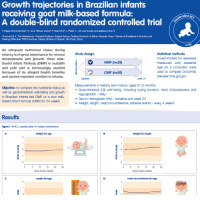
ESPGHAN poster: Brazilian RCT (Meijer-Krommenhoek et al. 2022)
3. Clinical study in China
A third clinical study was performed in China and investigated the growth of infants using Kabrita formula, cow’s milk formula (CMF) or human milk during six months.6 Z-scores for weight-for-age, weight-for-length and length-for-age of infants using Kabrita (n=104) were compared to the z-scores of infants using CMF (n=92) or human milk (n=68). The z-scores for weight-for-age is a parameter comparing the weight of an infant at a specific age to WHO reference growth charts. This study showed that the overall growth of infants using Kabrita formula and CMF did not differ from the growth of breastfed infants.
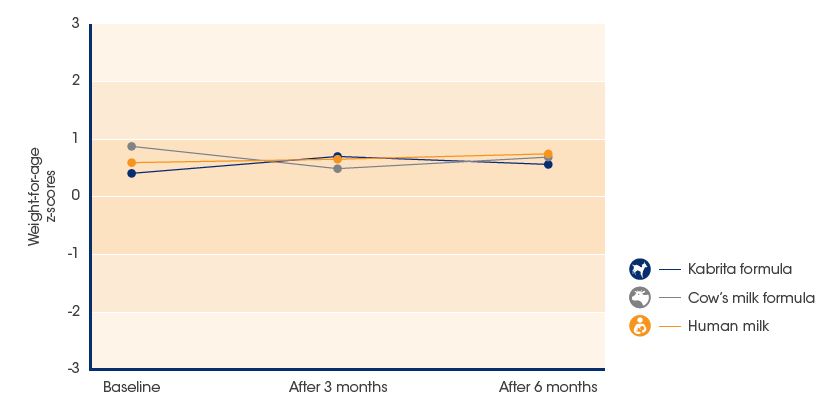
Moreover, no difference in symptoms of allergy was seen when comparing the Kabrita, CMF and human milk groups. This study showed that the growth of infants using Kabrita formula was similar to that of breastfed infants, indicating that the nutritional adequacy of Kabrita formula is comparable to that of breastmilk.6
Click on the ESPGHAN poster below for more information about this study.
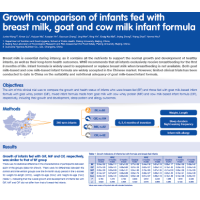
ESPGHAN poster: growth comparison Chinese infants (Wang et al. 2021)
4. Real world evidence in Chinese infants

Another study performed by Ausnutria’ s research team evaluated growth in Chinese term infants using Kabrita formula. Growth data were obtained via online questionnaires from 915 Chinese infants (519 boys, 396 girls) younger than 1 year of age. The z-scores for weight-for-age, length-for-age and BMI-for-age of the infants using Kabrita were comparable to the international WHO breastfed reference population. This study concluded that infants using Kabrita formula have normal growth patterns comparable to the WHO reference population. 7
5. Systematic review and meta-analysis of goat milk formula
In collaboration with The Medical University of Warsaw and Wageningen University, Ausnutria’s R&D department conducted a systematic review and meta-analysis, focussing on the effect of goat milk-based infant formula (GMF) on growth and safety in infants. 8,9 Four infant studies were included in this meta-analysis, with a total of 670 infants. The results showed that growth and safety parameters were similar among GMF and CMF-fed infants. To conclude, GMF is safe and suitable for use in infants from birth onwards.
Click on the Nutrients paper below for more information about this study.
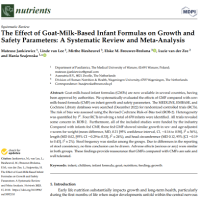
Paper: meta-analysis Jankiewicz et al 2023
Conclusion
The Ausnutria infant studies as well as other goat milk formula studies demonstrates that Kabrita goat milk formula supports healthy growth, is well tolerated and is safe to use in infants from birth onwards.
References
- 1. Park, Y.W. and G.F.W. Haenlein, Handbook of milk of non-bovine mammals. 2nd ed. 2017, Ames, Iowa: Blackwell Pub.
- 2. Clark, S. and M.B. Mora García, A 100-Year Review: Advances in goat milk research. Journal of Dairy Science, 2017. 100(12): p. 10026-10044.
- 3. EFSA Panel on Dietetic Products, N.a.A.N., Scientific Opinion on the suitability of goat milk protein as a source of protein in infant formulae and in follow-on formulae. EFSA journal, 2012. 10(3): p. 2603-2621.
- 4. He, T., et al., Goat milk based infant formula in newborns: A double-blind randomized controlled trial on growth and safety. Journal of Pediatric Gastroenterology and Nutrition, 2022. 75(2): p. 215-220.
- 5. Meijer-Krommenhoek, Y., et al. Growth trajectories in Brazilian infants receiving goat milk-based formula: A double-blind randomized controlled trial. Pediatric Gastroenterology and Nutrition, 2022. 74(S2):p. 998.
- 6. Wang J, L.X., Ma H, et al. Growth comparison of infants feed with breast milk, goat or cow milk infant formula. Journal of Pediatric Gastroenterology and Nutrition 2021. 72: p. 1181.31
- 7. van Lee, L., H. Boon, and K.e.a. Xie. Growth of Chinese infants fed goat milk based infant formula. Poster presented at NIZO conference. 2019.33
- 8. Jankiewicz, M., et al. The Effect of Goat-Milk-Based Infant Formulas on Growth and Safety Parameters: A Systematic Review and Meta-Analysis. Nutrients. 2023; 15(9):2110.
- 9. Biesheuvel, M., et al. The effect of goat milk-based infant formula on growth and safety in infants: A systematic review and meta-analysis. Pediatric Gastroenterology and Nutrition. 74(S2):1006, June 2022.


